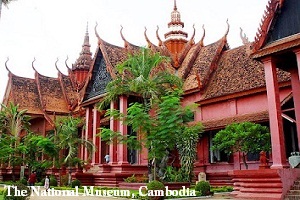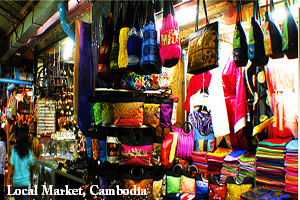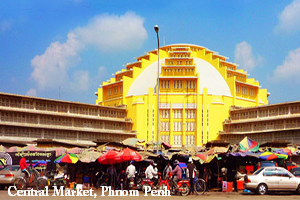|
Once considered as the most beautiful of the French built cities of Indochina, Phnom Penh’s enduring colonial charm has managed to transcend its once tumultuous past. A stroll through the leafy suburbs will find beautiful wide boulevards, sprawling colonial buildings, pavement restaurants, glittering palaces and pagodas, vibrant markets, and a bustling riverfront that made it the Paris of the East before 1970.
Before civil war broke out, Phnom Penh was nicknamed 'The Pearl of Asia' as it was considered one of the finest cities in the region. Located at the junction of the Mekong, Bassac and Tonle Sap rivers, Phnom Penh has been Cambodia’s capital for most of the last six centuries. Having recovered from the dark legacy of the Pol Pot era in the 1970’s, Phnom Penh today is a vibrant economic center with a population of two million. Cafes, restaurants and hotels line the riverfront while boutique shops and art galleries sprout along smaller side streets. Even as it undergoes urban development, Phnom Penh has retained much of its old world charm as evident in the French colonial architecture and traditional ornate temples. Rich in history, the city offers a number of cultural and historical sites.
Spending a few days in the capital city, visitors will not only uncover the historic sides of the country but also experience the true vibe of an emerging capital.
What to see in Phnom Penh?
Explore the Royal Palace, the structure you will be seeing today was constructed earlier this century on the site of the Banteay Kev, a citadel built in 1813. Visitors are only allowed to go inside the Palace’s Silver Pagoda and its surrounding compound. The Silver Pagoda, also known as Wat Preah Keo (Emerald Pagoda), was given its name because of over 5,000 silver tiles weighing 1 kilogram each that cover the floor.
To truly understand the country’s recent history and the people’s mindset that will jolt your soul and enlighten your mind, a visit to the Tuol Sleng Genocide Museum is a must. Also known as S-21, this former school became a torture center and has now been preserved as a museum. On the outskirts of Phnom Penh is the Killing Fields of Cheung Ek, an area where some 17,000 men, women and children were murdered and dumped in mass graves. Not for the faint-of-heart, these sites are sobering reminders of the Khmer Rouge’s brutality—and of the rest of the world’s failure to intervene.
For those with a passion for shopping there are many markets offering a selection of exquisite handicrafts including woven silks, silverware, carvings in stone and wood and precious gems. The Russian Market is popular among tourists and Cambodians alike. Located in southern Phnom Penh it is so called because of its popularity among Russian expatriates during the 1980s. While Central Market “Phsar Thmei”, one of the architectural sights of the city, has a beautiful 1935 Art Deco dome in what’s known as "colonial yellow," vaguely modeled after one of the temples near Angkor Wat.
An hour or two spent touring the city in a Cyclo or Tuk Tuk is one of most tourists’ favorite tours. These three wheeled rickshaws allow you to sit in comfort with the wind blowing in your face as your driver pedals you through the streets. Along the way, stop at a spiritual Wat Phnom, travel past the art-deco Central Market, and cruise the riverfront for a glimpse of the colonial buildings and local lifestyle of the people and why not take a sunset cruise up the mighty Mekong River to see the beauty of Phnom Penh at dusk.
For those interested in architecture, walking tours give you a different view of Phnom Penh. Follow a detailed map or go with a guide and explore the contemporary and ancient buildings of the city.
The most popular hangout in the evenings is the Sisowath Quay, on the Tonle Sap River, near the National Museum and the Royal Palace. One of the more pleasant places to eat on the Quay is the Foreign Correspondents’ Club (FCC), a lovely colonial-style building that is neither a club nor a place to find many foreign correspondents. But the service is friendly and the food, Western with a smattering of more local fare, is excellent.
Other key destinations outside Phnom Penh:
- Angkor Borei in Takeo province: Only 20 km from the provincial town of Takeo away (110 Km from Phnom Penh), the capital of the pre-angkorian kingdom of Funan (6th Century) and of Water Chenla (8th Century), the site is easy accessible by boat along a small river. Its museum displays reproductions of objects from this period and even some originals found in archeological sites in Indochina.
Another worthwhile excursion in Takeo is the Phnom Chiso Temple. On the top of the hill, there is an amazing view of the surrounding plains, with a fine Angkorian temple (Suryagiri -11th Century). A full day tour combined with a visit to Tonle Bati and a Khmer weaving village on the way long.
- Koh Dach (Silk Island) – locate about 30km north of the capital you will approach the heart of Cambodia. With few motorized vehicles on the island, enjoy leisurely strolls around the countryside and local villages where traditional silk weaving can be seen at almost every house. Complete the day with a marvelous sunset cruise back to Phnom Penh is amazing.
- Oudong Mountain- ancient capital of the Khmer Kingdom and crowning site of the king, located 40 km north of Phnom Penh, offers spectacular views on the surrounding country and the innumerable sugar palm trees that punctuate the countryside. King Ang Duong, the great grandfather of the present king was crowned here and many locals and foreign residents alike come to picnic here on weekends. On the way back to Phnom Penh, the detour to visit the Silver crafted village of Kampong Luong is a must.
- Kampong Chnnang – 90 km from Phnom Penh, a small floating village on the Tonle Sap River, makes for a great day trip where you will get a real taster for Khmer river life. Visit small temples and explore the unique lifestyles of the river people in a village where pottery is paramount.
- Kirirom National Park- On the edge of the Cardamom Mountains. Cambodia’s first established National Park is particularly popular due to its lakes and beautiful waterfalls hidden within the forest. It locate in Kampong Speu province about 90 km from the capital and takes almost 2-hour drive from Phnom Penh.
|








.png)
